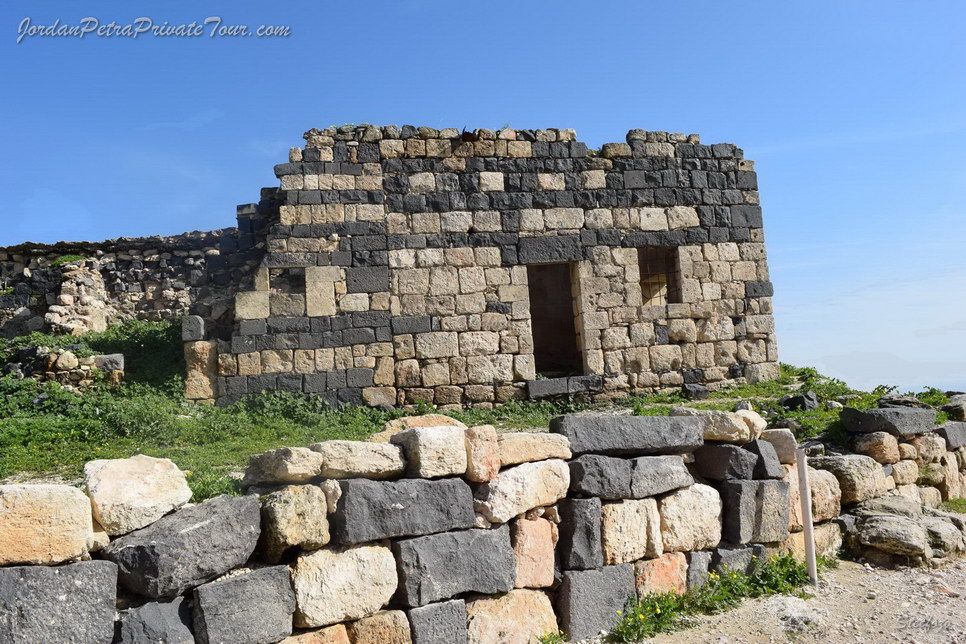Perched dramatically on a hilltop in northwestern Jordan, Umm Qais (ancient Gadara) is one of those rare places where history, landscape, and culture blend effortlessly. Standing amid its black basalt ruins, you can gaze across three countries at once — Jordan, Israel, and Syria — with the Sea of Galilee shimmering in the distance. Few places in the region capture the layered beauty of the Levant quite like Umm Qais.

A Walk Through Time
Once a member of the Decapolis, a league of ten Greco-Roman cities, Gadara was a thriving cultural hub known for its philosophers, poets, and panoramic views. Today, its well-preserved Roman theater, colonnaded streets, and Ottoman-era village offer a quiet but immersive glimpse into centuries of history.
As you wander through the ruins, the contrast between ancient stone and modern life is striking. Local families still live nearby, and the scent of thyme and olive trees drifts through the air. Don’t miss the Umm Qais Museum, housed in a restored Ottoman house — a charming space where Roman sculptures sit beside old olive presses.
The Best Time to Visit Umm Qais
The ideal time to visit is spring (March to May) or autumn (September to November). During these seasons, the hillsides around Umm Qais are lush and green, wildflowers bloom, and the weather is pleasantly mild — perfect for exploring on foot.
Summers can be quite hot, especially around midday, while winters bring occasional rain and fog that can obscure the famous views — though the mist adds a moody, almost mystical quality to the ruins.
Things to Do in and Around Umm Qais
-
Explore the Ancient Ruins
Take your time walking through the site — the Roman theater, basalt columns, and mosaic floors are incredibly photogenic. The view from the western terrace is unforgettable at sunset. -
Visit the Ottoman Village
The stone houses from the Ottoman period have been partially restored, and some now serve as cafés or guesthouses offering local food and herbal tea. -
Enjoy a Local Meal with a View
Stop at one of the small restaurants near the site — Umm Qais Resthouse is a favorite — where you can dine on traditional Jordanian dishes while overlooking the Sea of Galilee and the Golan Heights. -
Hike or Cycle the Umm Qais Trails
Outdoor enthusiasts can join guided treks through the Umm Qais Nature Reserve. Trails wind past olive groves, ancient springs, and dramatic cliffs. Cycling tours are also available for those who want a mix of culture and adventure. -
Soak in the Nearby Hot Springs
Just a short drive away are the Al-Himma hot springs, where locals have bathed for centuries. The mineral-rich waters are perfect for a relaxing soak after a day of exploring ruins.
Nearby Destinations Worth Visiting
-
Ajloun Forest Reserve (1 hour drive)
A peaceful nature escape with oak-covered hills and hiking trails. Visit the Ajloun Castle, a 12th-century fortress built by one of Saladin’s generals. -
Jerash (1.5 hours drive)
Another Decapolis city and one of the best-preserved Roman sites in the world. The scale of its colonnaded streets and temples is awe-inspiring. -
Irbid (30 minutes drive)
A lively university city with good dining options and a fascinating Archaeological Museum that complements what you’ll see in Umm Qais. -
The Jordan Valley and Sea of Galilee Viewpoints
Several scenic stops on the road down from Umm Qais offer incredible panoramas of the valley below, especially at golden hour.
A Quiet Gem in Northern Jordan
While much of Jordan’s tourism focuses on Petra or Wadi Rum, Umm Qais remains refreshingly under-visited. It’s a place to slow down, breathe in history, and appreciate the stunning natural beauty that has drawn travelers for millennia. Whether you come for a few hours or stay overnight, Umm Qais offers a serene counterpoint to the desert’s drama — a living reminder that Jordan’s stories are as vast and varied as its landscapes.
